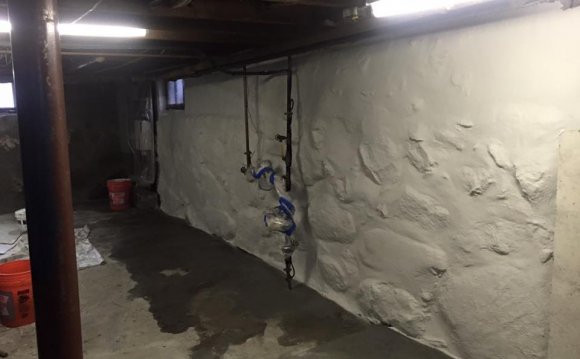
Accumulated Water - Deep Water on Basement Floor
Water Coming up through Floor Cracks
Possible Causes and Solutions:
Failed Footer Drains or Blocked French Drains
Hydrostatic Pressure
High Water Table

When water leakage gets deep in a basement, there is a good likelihood that there is a high water table, either temporarily or permanently. The water table is the level at which standing water is constant underground. Rainfall and snow melt will make the water table rise higher at times. Drought and lack of rainfall will allow the water table drop to a lower level underground.
Builders generally install drain tile, footer drains or even french drains to help prevent the water table from rising higher than footer level underneath the foundation and for relief of hydrostatic pressure. If the water table can be controlled, there is a good chance you can prevent water from leaking into the basement.
The inherent problem that these type of drainage systems face, is that they are susceptible to clogging by sediment. Because they are buried beneath the ground at footer level, water has to pass through a lot of soil to reach these systems. Ground water picks up soil, sediment, sand and mud as it travels down through the soil. Over time, accumulations of sediment can block the drain pipes. Once the drainage pipes are blocked, the water table can rise and create hydrostatic pressure underneath the basement floor and along the walls.
Remedies
Install a new drainage system -
New drain tile systems can be installed outside your foundation or inside your foundation. A dependable drainage system can provide long last control of the ground water and water table. Relief of the hydrostatic pressure, will go a long way toward preventing leaks in your basement.
Installing Outside Drain Tile – This requires hiring an excavation contractor to dig a trench around your home, down to footer level, usually 6 feet to 9 feet deep. Outside walls are generally pressure washed and cleaned. New parging or foundation coatings are placed on the exterior walls. The new drain tiles are then placed alongside the footers. The drain tiles usually will exit away from the home through a drainage trench, with a gravity flow pitch. The trenches around the home are filled in with gravel, filtering material and covered with soil. New grass can then be planted.
Check to see what kind of guarantee you will get with this type repair. Generally, most companies that do this sort of work will give you a 1 year warranty. A longer warranty is better. Check to see if repairs covered by the warranty include repairs to any mature landscaping, plants, sidewalks, driveways and other peripheral items that may be damaged or disturbed by additional digging.









